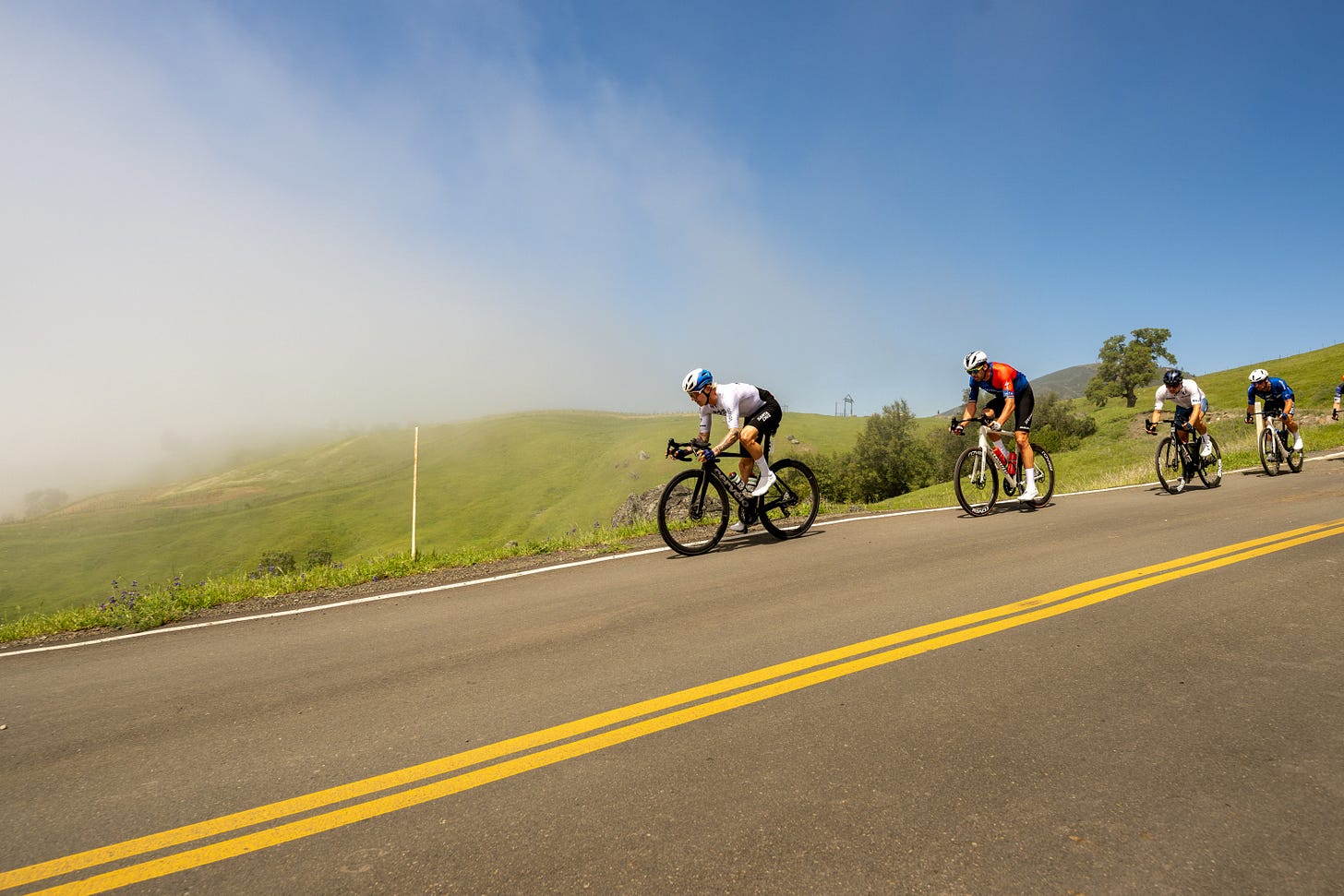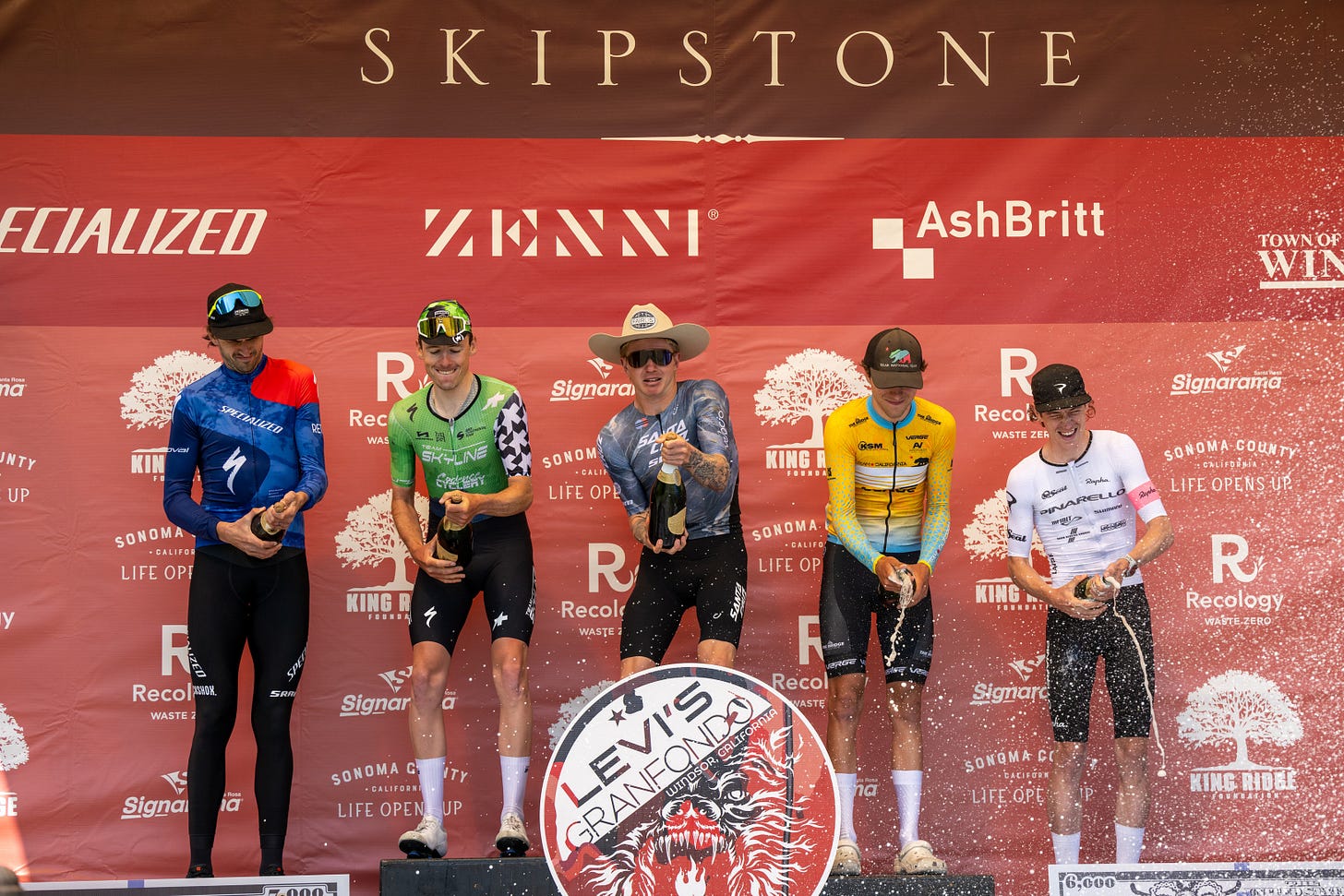$156,000, a livestream, and a dream of reviving American road racing
Can we make domestic road racing great again?
This article was originally written for Escape Collective. I’ve given a ‘sneak peek’ here, but then I’m going to push you to their site to read the full thing!
A six-figure prize pot, a functioning livestream, and a course that’d make the world’s best Ardennes riders quake – all in the gorgeous hills of northern California. Is American road racing back?
Levi’s Gran Fondo has been a staple on the NorCal cycling scene since 2009. It’s headed by the eponymous Levi Leipheimer, a man who needs little introduction [see footnote] to American bike racing fans.
But for 2025, the event upped the ante. It offered the biggest prize pot for any single-day bike race in the world, and provided a professionally filmed and commentated livestream. For seven hours in Sonoma Country, American racing fans were given a taste again of what a truly well-organised cycling event looks like.
This is the model
If you want to bring road racing back to America, for my money this is the model to do it.
You need a fondo ride (and the expo) to draw the in-person crowds, a livestream to capture eyeballs, and a big prize pot to attract the pros.
Levi’s offers seven different distances. There’s the ‘Family’ event which sits at 13 km all the way to the Growler, a 221 km epic with 4,227 meters / 13,868 ft of climbing. The start/finish line is in the town centre of Windsor, just north of Santa Rosa, where there’s live music all day, a big screen so fans can watch the livestream of the pros, and a quality expo. I looked around in awe; this is how it's done.
I hate to say it, but it’s almost taking the gravel (well, triathlon) business model – mass participation meets elite racing – and applying it to road racing. There were 1,953 entries to the event.
With a $156,000 prize purse (evenly divided between the men's and women's fields) and a professionally produced livestream, there’s no question that Levi’s Fondo had a large budget at its disposal.
To continue this article, head over to Escape Collective. In the meantime, read my thoughts below.
My Thoughts from Levi’s
Road Isn’t Dead
Mass participation underpins the future business model of road racing in the US, and maybe all domestic race scenes.
It’s a business model that’s been proven in triathlon and gravel. You have a Fondo where a few thousand people attend, and at the front, you have a pro race. It creates a solid income for the race organisers, and also the bonus of bringing your core audience to support the pro race too.
Road is far from dead. Being on the ground and through anecdotal evidence, all of my gravel racing friends loved either being back in, or taking a trip to road racing.
This is the model, but it’s still going to take a lot of external money.
No teams, support cars or radios is great
The race had no official teams, no neutral support, no convoy of cars, and no radios. It created carnage, but great carnage. Unofficial alliances were forming all over the road, attacks flying as nobody knew who was where and favourites were forced to pull out of the lead group to fix mechanicals.
It got me thinking how good it would be for there to be one road race a year in the World Tour with these rules? Everyone has radios linked to a race commissaire for safety reasons, and you’re allowed time gaps from the motorbikes. Bar that, nothing.
It forces you to race like juniors - it’s slightly idiotic, but wildly exciting.
Life Time has questions to answer
Levi’s Fondo had both a livestream and Tour de France-level commentary. It also had close to the amount of prize money as the Life Time Grand Prix overall.
I don’t want to dump on Life Time as they have done so much for the American and world cycling scene in the last few years. However, it’s hard not to look at them and question a few things after this weekend.
A livestream is much harder on gravel than road, but at the same time, things like that make a big difference. With their video production quality seemingly going steeply downhill at last week’s Sea Otter, I hope they step up for Unbound.
$156,000 is a lot of money
Putting up a big prize purse is raw professional sport.. There was $156,000 on the line across the two pro races. The Top 10 paid out, with $25,000 for the win.
It created something real to race for. The harder you raced and the more you pushed, the higher the chance of going home with cash in your pocket. It sounds mercenary, but sometimes that’s all it takes to make cracking bike racing.
Growing Pains
I take my hat off to the team that put the event on in California last weekend. The course was epic, well-marked and every little detail was thought about.
There are going to be a couple of growing pains. If this race continues to offer big prize pots and attract pros then we have to talk about a rolling road closure. I didn’t realise until a few minutes in that it wasn’t a rolling road closure, I crossed the yellow line to move up and immediately got a telling off from a moto-commissaire.
At that moment, I was a 17-year-old racing the National Circuit Series again.
That’s going to be the biggest problem, but it’s a question of safety. When you have over 150 pros racing at 50kph+ for the first hour of the race then we can’t have traffic coming towards us, it’s inviting an incident.
It’s going to be expensive, but it’s vitally important.
Dare to Dream?
Allow me to dream. A series of eight or ten one day races, with a few stage races sprinkled in too. The road races each have a Fondo underneath them and big prize money on the line for the winner.
There’s a livestream and commentary at each. They take place in some of the most iconic locations in the country. Some are flat, some are mountainous, maybe one has a time-trial…
Levi’s Fondo provided a blueprint for how it could be done and offered an alternate reality to the future of American racing. It’d just take a lot of money.
We’d be stealing a model from our friends in the triathlon world, but they seem to be doing just fine looking at the prize pots of T100 and Ironman…




